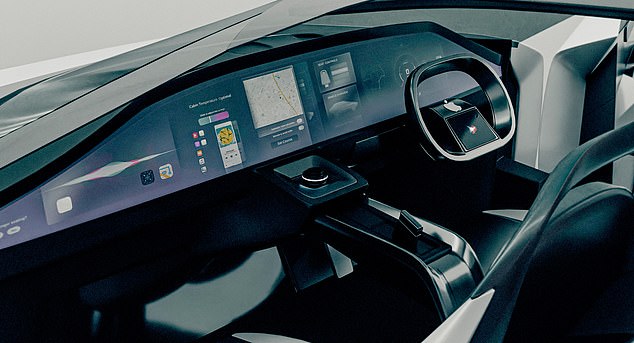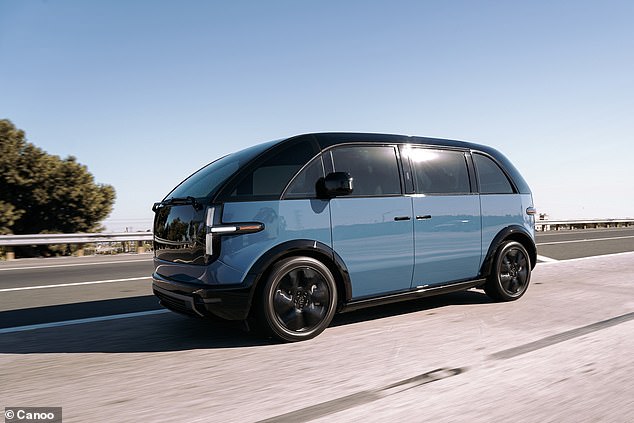The Apple Car that never was: New details about the tech giant’s scrapped electric vehicle reveal a futuristic-looking microbus with a ‘private jet’ interior
Apple killed off its ‘Apple Car’ last month after years of broken promises and while the world has never seen an actual photo, new details reveal what it could have been.
The features were shared by a trusted industry expert, who suggested the vehicle would have been a futuristic-looking microbus with a ‘private jet’ interior.
Mark Gurman, an Apple tipster, said the van-like car would feature an all-white exterior, self-driving capabilities and a giant screen inside for FaceTime calls, watching videos and scrolling through apps – just like the iPhone.
Experts had predicted the world could see the Apple Car in 2028, but it was subsequently scrapped after an internal memo was distributed to around 2,000 company employees in February.
The Apple car reportedly looked like a futuristic van, similar to a Canoo Lifestyle Vehicle (pictured)

The new version of the vehicle reportedly had gull-wing doors like those on a Tesla Model

One version of the Apple Car had an iPad-like feature
Apple had never officially confirmed when consumers could expect the vehicle’s release, but did announce it was abandoning the highly anticipated project after a decade in the making.
The company first began developing the Apple Car in 2014 as part of the so-called Project Titan, amid reports that Apple had set its sights on building electric vehicles since 2013.
While the world has yet to see a real photo of the tech giant’s car, and may never get one, Gurman gave his thoughts on what features it would have had.
Next to the white interior of the vehicle are whitewall tires with a black center and it appeared to have the same front and rear ends, which looked like something out of a futuristic, dystopian movie.
According to Gurman, author of the Boot up newsletter, the appearance of the Apple Car has changed several times, but it was reportedly always intended to have a minimalist appearance.
The interior would be decorated like a limousine or private jet, giving passengers the feeling of being in a ‘contoured bubble’ that can fit four people comfortably.
And the seats would have footrests and reclining options.
Although Gurman was confident the vehicle would have a center screen, he switched back and forth between a TV-sized screen or an iPad.

The Apple car has gone through several reported iterations, including one that resembles a 1950s Volkswagen. Pictured is a Canoo electric vehicle
Apple is said to have developed a unique air conditioning system that pushed air along the sides of the cabin – similar to that used in airplanes.
Gurman reported that other versions of the Apple Car included one that resembled a 1950s Volkswagen microbus and another that looked nearly identical to the 2017 Volkswagon ID Buzz prototype.
The last design Apple created was a variation on the microbus idea, adding wing-like doors similar to Tesla’s Model X instead of sliding doors.
It also reportedly switched from a Level 5 vehicle (meaning it was fully autonomous) to a Level 2 vehicle, which required Apple to add a steering wheel, pedals, and a front and rear window.
Apple CEO Tim Cook has been reluctant for years to confirm that the company was working on the Apple Car, despite reports that he had hired a team of car specialists in 2014 and 2015.
“There are products we are working on that no one knows about; which are not yet rumored,” Cook told The Wall Street Journal at the time.
People familiar with the matter told the newspaper that Cook had approved Project Titan a year earlier and then-vice president of product design Steve Zadesky was assigned to lead the group.
The Journal reported that Apple is known to make numerous prototypes for products it will never sell, but said the size of the project team and the number of seniors involved showed the company was serious about the vehicle.
About 2,000 employees were working on the car when Apple decided to cancel the project, reassigning many to the generative AI team, sending some to other internal departments or laying off staff.
